

On demand webinar: Change Management in Turbulent Times: Managing Unexpected,Ongoing Change During COVID & Other Crises. Elemental Change: Making stuff happen when nothing stands still (16 February 2021) by Neil Usher. eBook: Progressive Delivery eBook - How to do Continuous Delivery safely. On demand webinar: Leading Rapid Change. Elemental Change: Making stuff happen when nothing stands still (19 November 2020) by Neil Usher. How Do Projects Deal with Constant Change? Andy Jordan - November 11, 2020 Andy Jordan is President of Roffensian Consulting S.A., a Roatan, Honduras-based management consulting firm with a comprehensive project management practice.

Andy always appreciates feedback and discussion on the issues raised in his articles and can be reached at andy.jordan@roffensian.com. Andy's new book Risk Management for Project Driven Organizations is now available. In the last few years, it’s started to feel as though everything is changing all of the time. The periods of stability between changes have been getting shorter and shorter, whether we’re referring to a project subjected to frequent change requests, a piece of technology that is constantly being updated or replaced, or operational procedures that are being continuously refined. Coping with continuous change. Coping with continuous change Melanie Franklin Introduction We are constantly bombarded by new ideas, asked to change how we are currently doing things, expected to adopt new apps intuitively.
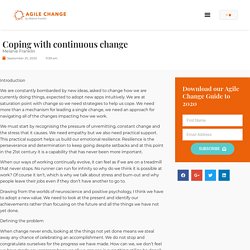
5 tips to improve employee attitudes about change management. Organizational change is inevitable, and anticipated by most employees these days.
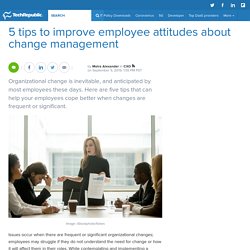
Here are five tips that can help your employees cope better when changes are frequent or significant. Issues occur when there are frequent or significant organizational changes; employees may struggle if they do not understand the need for change or how it will affect them in their roles. While contemplating and implementing a change, it will relieve employee stress if you include them in the planning process, encourage them to participate, and let them know that you care about the effect on their role. These five tips can help make change easier for your employees. 1. Creating urgency in advance can help avoid reaching an actual point of urgency later. 2. Planning and input are key. 3.
The best way to get and keep employee buy-in is to encourage participation in the change process wherever and whenever possible. The Pace of Change cartoon. “The pace of change has never been this fast, yet it will never be this slow again,” Justin Trudeau famously said in his 2018 speech at Davos.
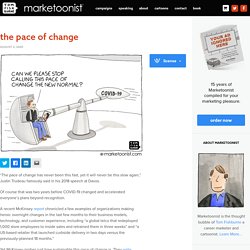
Of course that was two years before COVID-19 changed and accelerated everyone’s plans beyond recognition. A recent McKinsey report chronicled a few examples of organizations making heroic overnight changes in the last few months to their business models, technology, and customer experience, including “a global telco that redeployed 1,000 store employees to inside sales and retrained them in three weeks” and “a US-based retailer that launched curbside delivery in two days versus the previously-planned 18 months.” Performance Management During a Pandemic: Setting Goals Amid Constant Change. Performance management is the process of setting expectations, giving feedback, and addressing performance outcomes.
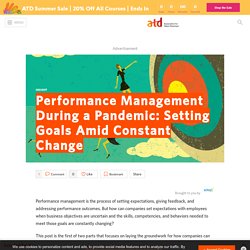
But how can companies set expectations with employees when business objectives are uncertain and the skills, competencies, and behaviors needed to meet those goals are constantly changing? This post is the first of two parts that focuses on laying the groundwork for how companies can effectively manage performance in a way that aligns with shifting business objectives and stays current with the changing skills, competencies, and behaviors employees need to meet those objectives. The Challenges of UncertaintyIt goes without saying that aligning performance management to business objectives during the COVID-19 pandemic is like trying to shoot a moving target. For instance, how many times have you heard these questions? LinkedIn by Jeff Skipper. L'organisation en mouvement: Adopter le changement permanent (janvier 2020) par Éric Delavallée.
Ten years in 10 weeks, all change. I think he’s right.

The pace and degree of change has not only been radical but has shown us what is possible – including much we would’ve considered wishful thinking just a few months ago. And so much of that emergency response includes attitudes and ways of working we should keep, whenever and however the pandemic ends. " What is the purpose of “the office” and what changes if these properties are no longer where the vast majority of work is done?” I’ve been having many conversations with chief executives and other leaders operating in financial services, retail, public sector and technology.
Change as continual adjustment vs. episodic disruption. The World is Changing Faster. OD10: What could help the society, organizations, teams and each of us during these times of rapid change. For this edition of the newsletter, we’ve selected the most practical, credible & well structured resources that we found for helping organizations, teams and each of us better deal with this period.

Also, we’re sharing an invitation to reflect about the contribution we could all have towards the greater good of the society we’re living in. And most importantly, please stay safe, both physically and mentally. If there is any specific topic that you’d like us to cover in a future edition of the newsletter, just hit reply and share it with us. We’ll do our best to address it, with clear ideas and practical tools that you can use with your team.
What I learnt about managing multiple changes came from finance. The concept of managing a set of projects of initiatives may be new in the area of change management, it is commonplace for a lot of large financial services firms in the project management arena.

The idea is that across a large number of projects, these are then divided into a few portfolios in order to better manage the outcomes within each portfolio, versus a scattered, project by project approach. Where did the concept of portfolio management come from? L'organisation en mouvement: Adopter le changement permanent (2020) par Eric Delavallée. How to Adapt to Constant Change: Create It. Story Highlights Constant change is the new normalFocus on people, not processesFour actions promote change leadership As leaders well know, constant change is the new normal in today's workplaces.
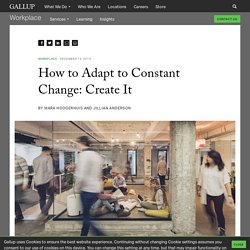
As a result, organizational agility is increasingly evasive. It's no longer enough to react to disruption -- or to delegate change management to HR or other internal functions. To get ahead of the competition, organizations need to flip the script on change and enable employees to lead change themselves. To prepare their people to help lead change, leaders need a workplace culture that lives and breathes adaptability -- a culture with agility in its DNA. A truly agile workplace culture empowers employees to think on their feet and spearhead innovation with ease. Leaders must fundamentally alter their approach to change management to create an adaptable work culture.
Digital Transformation: Preparing Your Organization For A World Of Constant Change. Six modèles pour conduire le changement en continu. Intelligent Technology, Experience In Continuous Change Era. Year after year, we all say that change is the new normal.
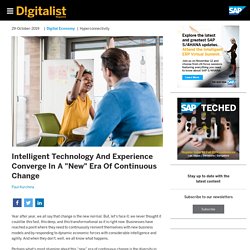
But, let’s face it, we never thought it could be this fast, this deep, and this transformational as it is right now. Businesses have reached a point where they need to continuously reinvent themselves with new business models and by responding to dynamic economic forces with considerable intelligence and agility. And when they don’t, well, we all know what happens. Perhaps what’s most stunning about this “new” era of continuous change is the diversity in which businesses are leaning into it. From business models focused on hydrocarbon reduction and renewables to those based on outcomes, intelligent services, and new-market creation, companies are accomplishing more than just shifting the paradigm of their brand.
How to Manage the Waves of Change. Managing change today is a lot like surfing. Just like waves, change never stops. No two waves are exactly alike, but there are patterns. Waves form, roll, peak and break. Often, the difference between catching the wave and missing it completely—a fate worse than a wipeout—is how well you understand the characteristics of that particular wave as it forms. How to Manage the Waves of Change. Change never sleeps. When can I take a break? Seven Techniques to Help You Thrive During Continuous Change. The Top Skills You Need To Lead In Times Of Continuous Change. In times of digital transformation, change has become a constant. Guiding companies through their business transformation journey not only requires creating more agile organizational structures and processes, it also demands instilling cultural change.
Business leaders need to transform their organization into an intelligent enterprise, rooted in a corporate culture that thrives on continuous change. The transformation has to start from the heart of the organization. One of the most striking results in the 22nd Annual Global CEO Survey by PwC was that organizations are turning inward to drive revenue growth in an unpredictable international socio-economic environment. They are focusing on strengthening the organization’s digital core, closing capabilities gaps, and improving organizational efficiencies.
Skills You Need To Lead In Times of Continuous Change. Business transformation: making change the new normal. Jack Welch, former chairman and chief executive of General Electric, knows better than most how change can affect a business. “When the rate of change on the outside exceeds the rate of change on the inside, the end is near,” he wrote in GE’s annual report at the turn of the millennium.
It’s an observation that seems even more pertinent now than it did then. When Mr Welch made the remark there were no smartphones, Mark Zuckerberg was just another high school student and the Twin Towers were still standing. How to Thrive Through Change. Organisation : gestion du changement - 6 conditions nécessaires. La gestion du changement ou change management a été le fer de lance des entreprises et des organisations pour faire face à l’évolution de leur environnement de manière ponctuelle.
De nos jours, où les changements s’enchainent (entreprise libérée, entreprise agile, uberisation…) en permanence ou se télescopent, il n’est plus possible de faire de la gestion du changement, il faut l’intégrer en continu. Ceci demande de reprendre parfois jusqu’à l’ADN même de l’entreprise. Quelles sont les points de vigilance et les évolutions nécessaires pour intégrer le changement en continu. Pourquoi faire du changement en continu la priorité ?
Le changement est la nouvelle donne de ce 21ième siècle qui a vu l’émergence de la complexité et de l’incertitude. L’adaptation ponctuelle à l’environnement ne suffit plus et la version top down de la conception de l’innovation et de l’adaptation est arrivée à son terme.